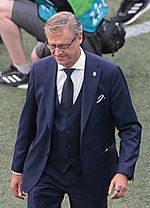Finland national football team facts for kids
The Finland national football team (called Huuhkajat or "The Eagle-owls" in Finnish) plays for Finland in international football games. It's managed by the Football Association of Finland, which started in 1907. Finland has been a member of FIFA since 1908 and UEFA since 1957.
For a long time, Finland didn't qualify for big tournaments. But in the 2000s, they started getting better, even reaching their highest FIFA World Ranking of 33rd in 2007. After a dip, they made history by qualifying for UEFA Euro 2020, their first major tournament! As of July 2025, they are working to improve their ranking and qualify for more big events.
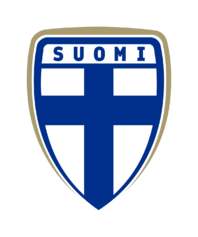 |
|||
| Nickname(s) | Huuhkajat (The Eagle-owls) |
||
|---|---|---|---|
| Association | Football Association of Finland | ||
| Confederation | UEFA (Europe) | ||
| Head coach | Jacob Friis | ||
| Captain | Lukas Hradecky | ||
| Most caps | Jari Litmanen (137) | ||
| Top scorer | Teemu Pukki (42) | ||
| Home stadium | Helsinki Olympic Stadium | ||
| FIFA code | FIN | ||
|
|||
| FIFA ranking | |||
| Current | 59 |
||
| Highest | 33 (March 2007) | ||
| Lowest | 110 (July–August 2017) | ||
| Elo ranking | |||
| Current | 53 |
||
| Highest | 30 (March 2002) | ||
| Lowest | 125 (1962–63) | ||
| First international | |||
(Helsinki, Finland; 22 October 1911) as Finland (Stockholm, Sweden; 29 May 1919) |
|||
| Biggest win | |||
(Helsinki, Finland; 11 August 1922) (Helsinki, Finland; 17 November 2010) |
|||
| Biggest defeat | |||
(Leipzig, Germany; 1 September 1940) |
|||
| European Championship | |||
| Appearances | 1 (first in 2020) | ||
| Best result | Group stage (2020) | ||
| Olympic Games | |||
| Appearances | 4 (first in 1912) | ||
| Best result | Fourth place (1912) | ||
| Baltic Cup | |||
| Appearances | 2 (first in 2012) | ||
| Best result | Runners-up (2012) | ||
Contents
Team History and Milestones
Early Days of Finnish Football
The Football Association of Finland started in 1907. Finland played its first international game on October 22, 1911, against Sweden. Finland also took part in the 1912 Summer Olympics in Stockholm, where they beat Italy and the Russian Empire. They finished fourth in the tournament.
Football After the Civil War
After the Finnish Civil War in 1918, sports in Finland were split. The national team only picked players from the Football Association. However, some top players from the Workers' Sports Federation later joined the Football Association to play for the national team. By 1956, the two football groups joined together.
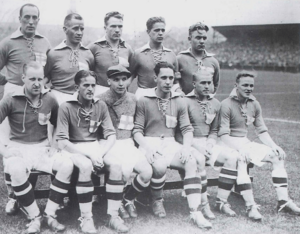
Mid-Century and Beyond
Finland hosted the 1952 Summer Olympics in Helsinki, but lost in the first round. They did win the unofficial Nordic Football Championship in 1964 and 1966. Finland started playing in European Championship qualifiers in 1968, but their first win didn't come until 1978.
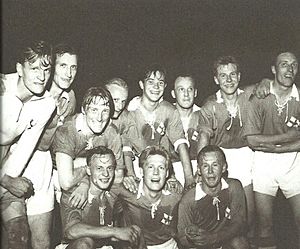
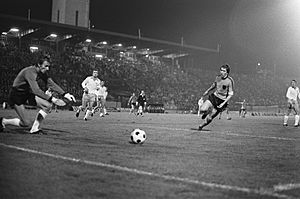
Late 20th Century Progress
In the mid-1990s, more Finnish players started playing in big European leagues, like Jari Litmanen at Ajax. In 1996, Richard Møller Nielsen, who had won the Euro 1992 with Denmark, became Finland's coach. The team had some good moments, like drawing with Norway and beating Switzerland. They almost made it to the 1998 FIFA World Cup play-offs, but an own goal in the last minute of their final game against Hungary ended their hopes.
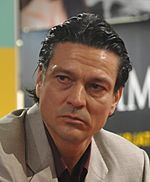
Early 2000s and Challenges
Antti Muurinen took over as coach in 2000. He had a very talented group of players, including Sami Hyypiä and Mikael Forssell, along with Litmanen. They played well in the 2002 FIFA World Cup qualification, drawing twice with Germany and once with England. However, they didn't qualify. Later, under Muurinen, results declined, and he was replaced in 2005.
Roy Hodgson became the coach in 2006. Finland came very close to qualifying for UEFA Euro 2008, needing a win against Portugal in their last game. The match ended in a 0-0 draw, and they missed out. However, this strong performance helped them reach their best-ever FIFA ranking of 33rd.
Recent Years and Euro 2020 Qualification
Under coach Markku Kanerva, Finland's ranking had dropped to 110th by 2017. However, Kanerva rebuilt the team. With key players like Teemu Pukki scoring goals and captain Lukas Hradecky making saves, Finland won their Nations League group and got promoted.
Then came the UEFA Euro 2020 qualification. On November 15, 2019, Finland made history by qualifying for their first major tournament, UEFA Euro 2020, after beating Liechtenstein 3-0. Teemu Pukki was a star, scoring ten goals in ten games. The tournament was moved to 2021 because of the COVID-19 pandemic.
At UEFA Euro 2020, Finland won their first-ever game in a major tournament, beating Denmark 1-0 with a goal from Joel Pohjanpalo. Sadly, they lost their next two games and were knocked out in the group stage.
Finland did not qualify for the 2022 FIFA World Cup. They also missed out on UEFA Euro 2024 after losing a play-off match to Wales in March 2024.
Markku Kanerva's time as coach ended in November 2024. He had brought in many new, younger players like Kaan Kairinen and Oliver Antman, helping the team improve its FIFA ranking to 63rd by summer 2024.
New Coach: Jacob Friis
On January 20, 2025, Jacob Friis from Denmark was announced as the new head coach for the Finland national team. He signed a three-year deal. His first official matches were in March 2025 for the 2026 FIFA World Cup qualification.
Home Stadiums


Most of Finland's home games are played at the Helsinki Olympic Stadium in Helsinki. It has been their main stadium since it was built in 1938. Other stadiums like Tampere Stadium and Veritas Stadion have also hosted games. During the renovation of the Helsinki Olympic Stadium from 2016 to 2020, Tampere Stadium was the main venue. The team returned to the renovated Helsinki Olympic Stadium in 2020.
Team Kits and Sponsors
Finland's football kits are currently made by the American brand Nike. Before Nike, the German company Adidas supplied their kits from 1979 to 2013.
|
|
| Finland's home kit worn at UEFA Euro 2020 |
Current Team Players
Current Squad Members
Here are the players who were called up for the FIFA World Cup qualification matches in June 2025. Caps and goals are updated as of June 10, 2025, after the match against Poland.
| No. | Pos. | Player | Date of birth (age) | Caps | Goals | Club |
|---|---|---|---|---|---|---|
| 1 | GK | Lukas Hradecky (captain) | 24 November 1989 | 101 | 0 | |
| 12 | GK | Jesse Joronen | 21 March 1993 | 20 | 0 | Free agent |
| 23 | GK | Viljami Sinisalo | 11 October 2001 | 3 | 0 | |
|
|
||||||
| 2 | DF | Juhani Pikkarainen | 30 July 1998 | 1 | 0 | |
| 3 | DF | Ville Tikkanen | 10 August 1999 | 0 | 0 | |
| 4 | DF | Robert Ivanov | 19 September 1994 | 39 | 0 | Free agent |
| 5 | DF | Arttu Hoskonen | 16 April 1997 | 19 | 1 | |
| 15 | DF | Miro Tenho | 2 April 1995 | 8 | 0 | |
| 17 | DF | Nikolai Alho | 12 March 1993 | 44 | 0 | |
| 18 | DF | Jere Uronen | 13 July 1994 | 74 | 1 | |
| 22 | DF | Ilmari Niskanen | 12 October 1997 | 25 | 1 | |
|
|
||||||
| 6 | MF | Glen Kamara | 28 October 1995 | 68 | 2 | |
| 7 | MF | Tommi Jyry | 16 August 1999 | 0 | 0 | |
| 8 | MF | Robin Lod | 17 April 1993 | 78 | 6 | |
| 9 | MF | Fredrik Jensen | 9 September 1997 | 36 | 8 | |
| 13 | MF | Onni Valakari | 18 August 1999 | 12 | 1 | |
| 14 | MF | Kaan Kairinen | 22 December 1998 | 23 | 1 | |
| 16 | MF | Matti Peltola (vice-captain) | 3 July 2002 | 18 | 0 | |
| 21 | MF | Anssi Suhonen | 14 January 2001 | 10 | 0 | |
| MF | Matias Siltanen | 29 March 2007 | 0 | 0 | ||
|
|
||||||
| 10 | FW | Teemu Pukki (vice-captain) | 29 March 1990 | 130 | 42 | |
| 11 | FW | Oliver Antman | 15 August 2001 | 22 | 7 | |
| 19 | FW | Benjamin Källman | 17 June 1998 | 31 | 8 | |
| 20 | FW | Joel Pohjanpalo (vice-captain) | 13 September 1994 | 81 | 18 | |
Recently Called-Up Players
These players have been called up in the last year and could still be selected.
| Pos. | Player | Date of birth (age) | Caps | Goals | Club | Latest call-up |
|---|---|---|---|---|---|---|
| GK | Carljohan Eriksson | 25 April 1995 | 1 | 0 | v. |
|
|
|
||||||
| DF | Tuomas Ollila | 25 April 2000 | 5 | 0 | v. |
|
| DF | Daniel O'Shaughnessy | 14 September 1994 | 23 | 1 | v. |
|
| DF | Noah Pallas | 9 February 2001 | 3 | 0 | v. |
|
| DF | Adam Ståhl | 8 October 1994 | 3 | 0 | v. |
|
| DF | Leo Väisänen | 24 July 1997 | 28 | 0 | v. |
|
| DF | Tomas Galvez | 28 January 2005 | 5 | 0 | v. |
|
|
|
||||||
| MF | Roman Eremenko | 19 March 1987 | 73 | 5 | v. |
|
| MF | Rasmus Schüller (vice-captain) | 18 June 1991 | 79 | 0 | v. |
|
| MF | Urho Nissilä | 4 April 1996 | 15 | 0 | v. |
|
| MF | Leo Walta | 24 June 2003 | 6 | 0 | v. |
|
|
|
||||||
| FW | Daniel Håkans | 26 October 2000 | 12 | 4 | v. |
|
| FW | Topi Keskinen | 7 March 2003 | 4 | 0 | v. |
|
| FW | Santeri Haarala | 17 December 1999 | 0 | 0 | v. |
|
|
||||||
Player Records
These tables show the players with the most games played and the most goals scored for Finland. Players who are still active are highlighted in blue.
Most Games Played
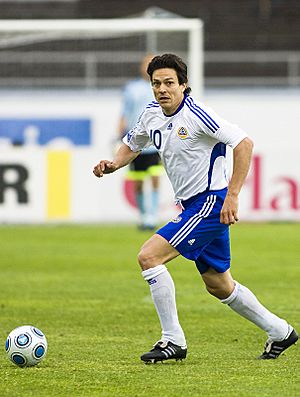
| Rank | Player | Caps | Goals | Career |
|---|---|---|---|---|
| 1 | Jari Litmanen | 137 | 32 | 1989–2010 |
| 2 | Teemu Pukki | 130 | 42 | 2009–present |
| 3 | Jonatan Johansson | 106 | 22 | 1996–2010 |
| 4 | Sami Hyypiä | 105 | 5 | 1992–2010 |
| 5 | Lukas Hradecky | 101 | 0 | 2010–present |
| 6 | Ari Hjelm | 100 | 20 | 1983–1996 |
| 7 | Joonas Kolkka | 98 | 11 | 1994–2010 |
| 8 | Mikael Forssell | 87 | 29 | 1999–2014 |
| 9 | Erkka Petäjä | 84 | 0 | 1983–1994 |
| Tim Sparv | 84 | 1 | 2009–2021 |
Top Goal Scorers
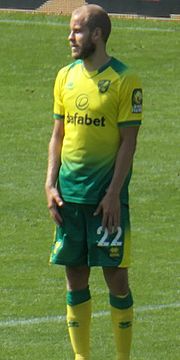
| Rank | Player | Goals | Caps | Ratio | Career |
|---|---|---|---|---|---|
| 1 | Teemu Pukki | 42 | 130 | 0.32 | 2009–present |
| 2 | Jari Litmanen | 32 | 137 | 0.23 | 1989–2010 |
| 3 | Mikael Forssell | 29 | 87 | 0.33 | 1999–2014 |
| 4 | Jonatan Johansson | 22 | 106 | 0.21 | 1996–2010 |
| 5 | Ari Hjelm | 20 | 100 | 0.2 | 1983–1996 |
| 6 | Mixu Paatelainen | 18 | 70 | 0.26 | 1986–2000 |
| Joel Pohjanpalo | 18 | 81 | 0.22 | 2012–present | |
| 8 | Verner Eklöf | 17 | 32 | 0.53 | 1919–1927 |
| 9 | Aulis Koponen | 16 | 39 | 0.41 | 1924–1935 |
| Gunnar Åström | 16 | 44 | 0.36 | 1923–1937 |
Team Achievements
Regional Cups
- Baltic Cup
- Runners-up (1): 2012
- Third-place (1): 2014
- Nordic Football Championship
- Champions (1): 2000–01
Friendly Tournaments
- King's Cup
- Runners-up (2): 2000, 2013
- Cyprus International Football Tournament
- Champions (1): 2005
More About Finnish Football
- Finland men's national under-21 football team
- Finland women's national football team
- Football in Finland
See also
 In Spanish: Selección de fútbol de Finlandia para niños
In Spanish: Selección de fútbol de Finlandia para niños



